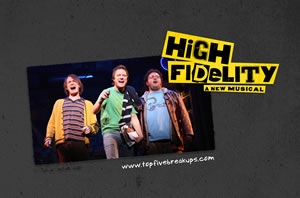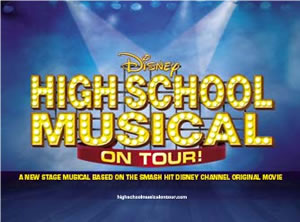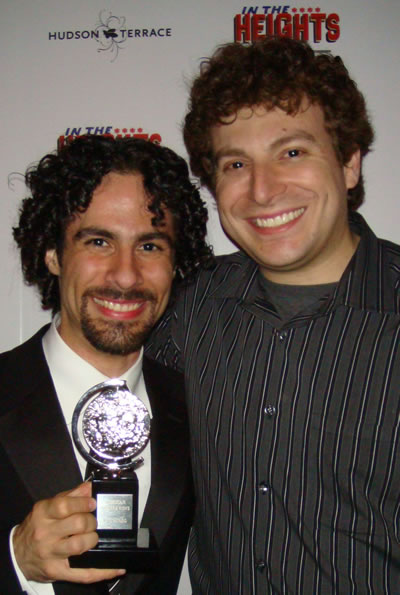
Spotlight on: Randy Cohen, Broadway Keyboardist / Programmer / Music DirectorRandy Cohen is a classically trained pianist who graduated Oberlin College with a music degree and has been involved with musicals since attending High School. He became hooked on synthesizers at an early age, and his first keyboard was a Korg M1. In college, became actively involved in various theater productions and jury-rigged his first pit keyboard setup using some DX7s, some Proteus modules, and two PCs running Cakewalk Jukebox... and it kinda worked! At that point, he apparently became addicted to the thrill of live theater, and several years later he found himself in New York, where he worked his way up as both a player and a programmer.
"For High Fidelity, there was one Receptor for both the Keyboard 1 and Keyboard 2 parts. The MIDI output from both of the keyboards was merged into the one Receptor, which allowed the one Receptor to cover both books. This really opened my eyes to the fact that you really can do better than just having 128MB of memory to work with!" Free of the 128MB RAM limitations of Kurzweil, Akai, and E-MU samplers, new sonic potential was unleashed and Randy was sold with the potential of Receptor. In comparison to hardware samplers with their 128MB memory limitation, Receptor offers 2GB of RAM along with the ability to stream samples off disc, making it possible to use sample libraries that are dozens and even 100's of gigabytes in size.
"Receptor is great for the High School Musical Tour because they just get into place, plug in their MIDI cable and they're ready to go. The Receptor has been great – the only time they had an issue was when they had a power problem at the venue but that affected everything." Randy soon found himself working with more orchestrators doing programming and working with orchestrators on more shows, such as Young Frankenstein, Cry Baby, and the recent Tony award winner for Best Musical in 2008: In The Heights.
Of course Receptor is also present in shows that Randy hasn't worked on, such as Legally Blonde – The Musical, Aspects of Love, and The Wedding Singer. In each case, Receptor has earned its place in these musicals due to the quality of sounds and the versatility it can provide. Whether the call is for truly realistic pianos, organs, electric pianos, supplementing acoustic brass or strings, or for mallet percussion that is virtually indistinguishable from its more costly and space-hogging acoustic equivalent, Receptor is quickly becoming the first call of Broadway and London's West End programmers. Starting at the Top of the Show… The larger the production, the more pressure there is on the entire production staff, programmer included. There are deadlines, budgets, and performance standards that have to be upheld, but surprisingly the biggest challenge that faces programmers is keeping their rigs simple. The musicians playing in the pit need to worry about the music and pay attention to the conductor, and any distractions have to be kept to a minimum. So Randy programs his rigs using a footswitch to increment through the patches, so all the player has to do is push the footswitch at the right time to get the right sound to come up. And f course, they can go back if they overstep. In the ideal world, turning on the keyboard and rack is all that the player should have to do. The programmer really needs to think about not only the player, but the sub. Many shows will run for many months on end, and sometimes many years, so more than one person is likely to play a run. The programmer needs to be sensitive to the sub who comes in once every two months – they likely won't know the rig in and out, so the simple it is, the better. Add to this the fact that very often the player of the 'Keyboard 1' or 'Keyboard 2' book is usually not a synth programmer themselves, and there is a lot of pressure on to keep things as simple and reliable as possible. Randy takes a interesting approach to programming a show, preferring to simply load different plug ins on different channels on Receptor, and leave them instantiated for the whole show as opposed to using a more advanced programming tool such as Snapshots. He says that his reason for this is not anything to do with snapshots, but his desire to do as much programming in the controller as possible so as to make it as idiot-proof as possible. So he'll load up, say, 14 channels with instruments, and then pick and choose from those channels using MIDI messages sent on different MIDI channels using a Motif or an S90 as a controller. The only downside of this approach is that you end up using the CPU to run plug-ins that aren't making music unless they are receiving MIDI messages, but the simplicity of the programming approach makes up for that fact. Big sound, small size…The Advantages of Virtual Instruments in the Pit This brings up the important point that the choice of Receptor is not only based on sounds, based also based on the footprint of the rig. One nagging issue for modern shows is the size of the pit. As shows become more elaborate in their staging, there is typically less room for musicians, making space in the pit a premium. Receptor brings truly authentic sounds that alleviate the need for an acoustic piano or Rhodes or Wurly, and make an orchestra sound bigger than it actually is. Not only will Receptor provide far better and more realistic sounds than what a hardware synth might provide, it also provides the additional flexibility of being able to locate the Receptors wherever its convenient- including out of the pit – requiring only a long MIDI cable. Of course, in an ideal world where there are no budget or space constraints, Randy would prefer to use a real grand piano. Who wouldn't? But often that is simply not an option or simply isn't practical. And there are upsides to being all electronic as well, for example, it simplifies the job of miking the orchestra by eliminating bleed from drums or horns in to the piano or organ microphones. Achieving Harmony and Balance between Electronic and Acoustic instruments "When synths first appeared in the pit, everyone was pushing for replacing instruments with technology. There was a whole uneasy period where people didn't understand what the technology meant, since it was something new. Was it going to take away jobs? Was it going to add jobs? I think that time is passed now, and musicians understand that technology is great as long as it is used the right way – as a way to improve the overall sound and not serve as a replacement for live musicians." As a player himself, Randy understands the need to view technology as "cornstarch" that can be used to thicken the sound of a score that emphasizes acoustic instruments; but use too much and you've lost all subtlety in the texture and you end up with a goopy mess. Randy's approach is that high quality sounds are best used to "fill out" an ensemble, effectively adding players to the orchestra that otherwise wouldn't be there, supplementing instrumentalists to make them sound fuller, as well as adding instrumentation that is cumbersome, difficult to play, or seldom used. He cautions against using synthesized sounds as full replacements for brass or string instruments, since nothing can replace the articulation, subtlety and natural variations that occur when those instruments are played, and warns that even an unsophisticated listener can tell that something just "doesn't sound quite right". "I'm a proud member of (American Federation of Musicians Local) 802, so my view is that keyboards are new tools that should not be used to replace players, instead they should be used to enhance the players that are already there, and when electronics are combined with acoustic instruments, you can make what was previously good sound great" In particular, Randy mentions how important it is to score electronic instruments to supplement inner harmonies and sections, and to make sure that an acoustic instrument played by an instrumentalist is always playing the highest and the lowest notes in an ensemble. Using synths to "fill in the middle" can make a four person brass section or string section double in size, and as long as it is scored properly. The results can be tremendous, making the section sound much thicker than it ever would given the instrumentation. Again, the analogy to corn starch is particularly appropriate here. This matter obviously applies less to modern shows where electronic instruments are part of the score to begin with, like the Tony-award-winning "In the Heights". Randy became involved with In The Heights when it was off-broadway, and has followed it on-broadway to its recent Tony win: "It was great programming In the Heights for the simple reason that there were no expectations about how the show should sound, and it quickly developed its own unique sound. For a long time Broadway shows reflected the music of that era, and it makes sense that we're going back into that kind of thing. I have virtual instruments all over that show – I'm using Elektrik Piano for Wurlys, I have Ivory, B4II for organ sounds… its great having a show where the technology to make sounds is used for their own sake – no controversy, just great sounds. In The Heights has two keyboard players, and each keyboard player has two Receptors – one main unit and one backup. The controller is connected to a MIDI switch that allows them to switch instantly from one unit to the other should anything go wrong. They've only had to switch over to a back up unit once in one show during the entire run… so far so good " When asked about the reliability of Receptor, Randy is quick to defend the reputation of Receptor: "Every technology has its own problems at some point, very often I've discovered its not the actual piece's fault, as much as it is an outside influence…perhaps an operator error, or a power fluctuation, or a bad cable… it could be anything. So I've found its good to have a backup running not only because its good to have something you can go to in a moments notice, but it also helps your piece of mind, so if something does happen in the middle of a show, you can switch over quickly." Another place where Receptor shows its strength in the percussion section: So what does Randy do when he's not programming keyboards, or playing keyboards in the pit? Conducting, of course. Randy is also a music conductor, and is currently the Assistant Conductor of SPAMALOT, the Monty Python musical. Night after night the lights go down and the curtains go up on audiences clutching their Playbills, ready to be transported to another time, another place… another life. And through the efforts of the hundreds of dedicated and talented individuals who contribute to a show such as Randy Cohen, and a little bit of technological magic in the form of a Receptor, the emotional impact becomes an unforgettable experience that only live theater can deliver.
In The Heights Music Director/Orchestrator Alex Lacamoire |



 One of Randy's first gigs was working as an assistant programmer to his friend Jim Abbott, also a Broadway show programmer. Jim turned him on to Receptor when he was looking for keyboard rigs that could run plug-ins like Ivory and B4II. So Jim spec'd a Receptor in to the Broadway musical version of the hit film High Fidelity to see how well it would perform.
One of Randy's first gigs was working as an assistant programmer to his friend Jim Abbott, also a Broadway show programmer. Jim turned him on to Receptor when he was looking for keyboard rigs that could run plug-ins like Ivory and B4II. So Jim spec'd a Receptor in to the Broadway musical version of the hit film High Fidelity to see how well it would perform.  With their success with High Fidelity, Randy had no hesitation in recommending Receptor for the National Tour of High School Musical, using Receptor for the keyboard 1 book with Ivory and Elektrik Piano, all being controlled by a Yamaha S-90 controller.
With their success with High Fidelity, Randy had no hesitation in recommending Receptor for the National Tour of High School Musical, using Receptor for the keyboard 1 book with Ivory and Elektrik Piano, all being controlled by a Yamaha S-90 controller. 


